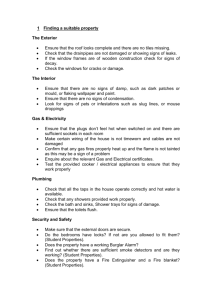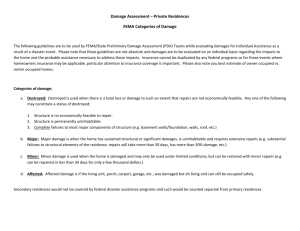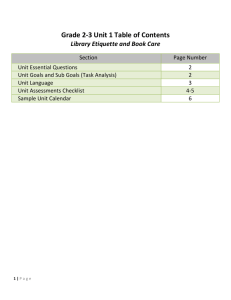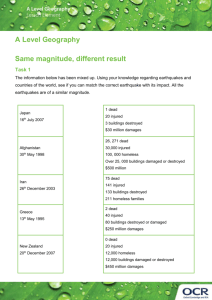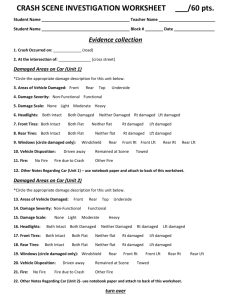Local Initial Damage Assessment Form Instructions
advertisement
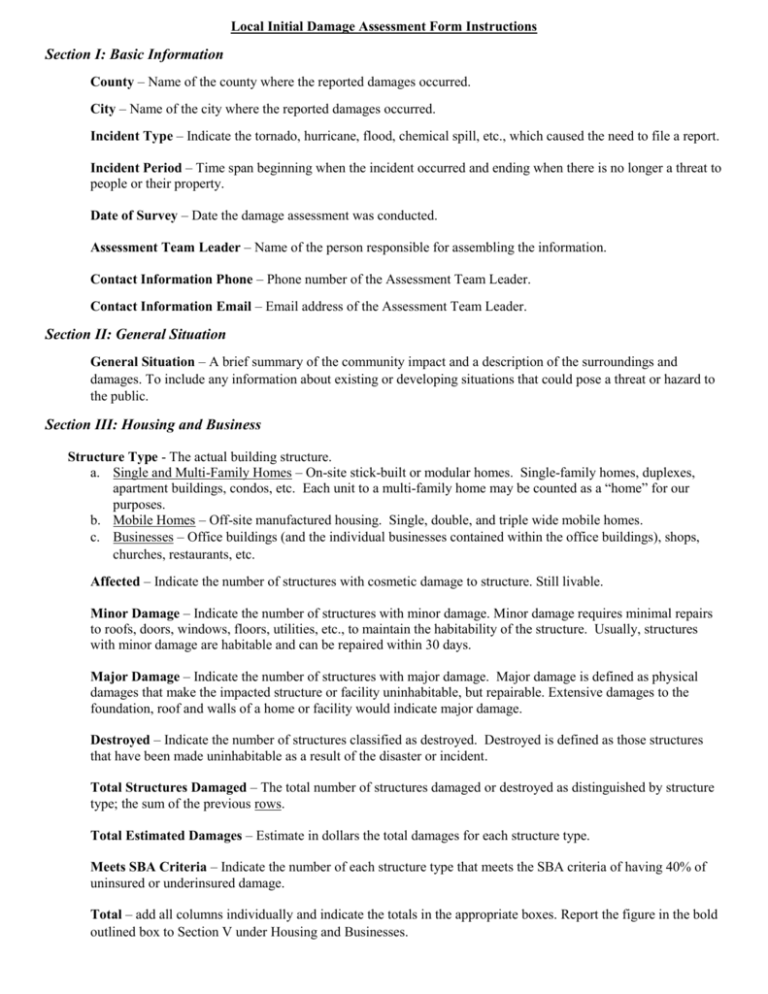
Local Initial Damage Assessment Form Instructions Section I: Basic Information County – Name of the county where the reported damages occurred. City – Name of the city where the reported damages occurred. Incident Type – Indicate the tornado, hurricane, flood, chemical spill, etc., which caused the need to file a report. Incident Period – Time span beginning when the incident occurred and ending when there is no longer a threat to people or their property. Date of Survey – Date the damage assessment was conducted. Assessment Team Leader – Name of the person responsible for assembling the information. Contact Information Phone – Phone number of the Assessment Team Leader. Contact Information Email – Email address of the Assessment Team Leader. Section II: General Situation General Situation – A brief summary of the community impact and a description of the surroundings and damages. To include any information about existing or developing situations that could pose a threat or hazard to the public. Section III: Housing and Business Structure Type - The actual building structure. a. Single and Multi-Family Homes – On-site stick-built or modular homes. Single-family homes, duplexes, apartment buildings, condos, etc. Each unit to a multi-family home may be counted as a “home” for our purposes. b. Mobile Homes – Off-site manufactured housing. Single, double, and triple wide mobile homes. c. Businesses – Office buildings (and the individual businesses contained within the office buildings), shops, churches, restaurants, etc. Affected – Indicate the number of structures with cosmetic damage to structure. Still livable. Minor Damage – Indicate the number of structures with minor damage. Minor damage requires minimal repairs to roofs, doors, windows, floors, utilities, etc., to maintain the habitability of the structure. Usually, structures with minor damage are habitable and can be repaired within 30 days. Major Damage – Indicate the number of structures with major damage. Major damage is defined as physical damages that make the impacted structure or facility uninhabitable, but repairable. Extensive damages to the foundation, roof and walls of a home or facility would indicate major damage. Destroyed – Indicate the number of structures classified as destroyed. Destroyed is defined as those structures that have been made uninhabitable as a result of the disaster or incident. Total Structures Damaged – The total number of structures damaged or destroyed as distinguished by structure type; the sum of the previous rows. Total Estimated Damages – Estimate in dollars the total damages for each structure type. Meets SBA Criteria – Indicate the number of each structure type that meets the SBA criteria of having 40% of uninsured or underinsured damage. Total – add all columns individually and indicate the totals in the appropriate boxes. Report the figure in the bold outlined box to Section V under Housing and Businesses. Section IV: Public Facilities Facility Type – A building, works, system or equipment that is built, manufactured or maintained. a. State Government – refers to all facilities owned by the State of South Carolina. b. Local Government – refers to all facilities owned by the City or County governments. c. Private Non-Profit – refers to all facilities owned by PNP entities that perform a government-type service. Total Number Damaged – Indicate the number of facilities damaged as distinguished by facility type. Category A – Indicate the estimated dollar cost for debris removal. The formula to be used to calculate the estimated dollar cost is the number of cubic yard (CY) x $10. Category B – Indicate the estimated cost of expenses incurred for emergency protective measures. To include labor, equipment, and materials used in responding to the incident. Categories C - G – Indicate in estimated dollars the combined amount of losses for roads, signs, bridges, water control facilities, building and equipment, utilities, parks, recreational and other facilities. *Total* – Indicate in estimated dollars for the individual rows of Category (A-G) Damage. Report the figure in the bold outlined box to Section V under Public Facilities. NOTE: The number in the total number damaged column cannot be included in this figure because it is not a dollar figure. Total – Indicate the totals for each column. Section V: Total Damages Homes and Businesses – Indicate the total damages in estimated dollars from Section II: Housing and Businesses. Public Facilities – Indicate the total damages in estimated dollars from Section IV: Public Facilities. GRAND TOTAL – The total sum of the Homes and Businesses and Public Facilities columns. Section VI: Utilities Indicate the total number of listed systems that maintain the infrastructure for a public service that are damaged or destroyed. Section VII: Roads and Bridges Roads/Streets Damaged – Indicate the number of roads damaged but passable. Roads/Streets Blocked – Indicate the number of roads that are impassable due to damage or debris. Bridges damaged but usable – Indicate the number of bridges damaged but usable with caution. Bridges damaged and unusable – Indicate the number of bridges destroyed or determined usuable. Section VIII: Dams and Levees Dam/Levee Location – Indicate the dam/levee location. Threatened – Indicate the number of dams/levees topped, have cracks or are close to being breached. Damaged – Indicate the number of dams/levees that have received damage but are still stable. Destroyed – Indicate the number of dams/levees that have been breached due to the disaster.
